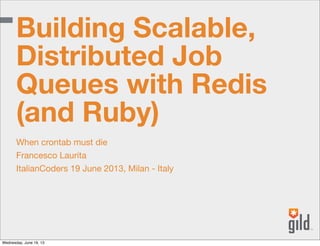Building Scalable, Distributed Job Queues with Redis and Ruby
- 1. When crontab must die Francesco Laurita ItalianCoders 19 June 2013, Milan - Italy Building Scalable, Distributed Job Queues with Redis (and Ruby) Wednesday, June 19, 13
- 2. Playing with your backend A Front End request is supposed to return a response really fast There are certain actions that may take longer and can’t be executed “live” * Processing an order (fraud detection, external service call) * Converting a video * Resizing an Image * In general, Not customer-facing operations that might take longer than few milliseconds (even delivering an email) Wednesday, June 19, 13
- 3. Processing Jobs: The wrong way (crontab) • It loads your database • Almost impossible to scale • Painful errors recovery • Waste of time between each schedule Wednesday, June 19, 13
- 4. Processing Jobs: The wrong way (crontab) • It loads your database • Almost impossible to scale • Painful errors recovery • Waste of time between each schedule Wednesday, June 19, 13
- 5. Processing Jobs like a pro: Message Queue • A producer pushes a message into a jobs queue • One ore more consumer consume messages from a job queue LPUSH RPOP RPUSHLPOP Wednesday, June 19, 13
- 6. Processing Jobs like a pro: Message Queue Wednesday, June 19, 13
- 7. Our choice: Redis What is it? * Is a NoSQL DB * Is an advanced Key/Value Store * Is a caching server * Is a lot of things... Wednesday, June 19, 13
- 8. Our choice: Redis What is it? * It is a way to share Memory over TCP/IP Can share memory (data structure) between different processes and languages * List (LinkedList) --> queue.pop, queue.push * Hash --> {} * Set --> Set * SortedSet --> SortedSet.new * .... Wednesday, June 19, 13
- 9. A real use case Q1 Q2 Q4 Q5 S1 S2 Q3 Q6 Qi = queue i | Sj = service j S3 Wednesday, June 19, 13
- 10. Simple Queue vs Reliable Queue Simple queue: 1) pushing values into a queue 2) a consumer waits for these values using polling or a blocking operation * Is not reliable: a message can be lost - Network problems - Consumer crashes while consuming message Wednesday, June 19, 13
- 11. Simple Queue vs Reliable Queue Reliable queue: 1) pushing values into a queue 2) a consumer fetches a message and at the same time pushes it into a processing list 3) remove the message from the processing list once message has been processed Wednesday, June 19, 13
- 12. Simple Queue vs Reliable Queue Messages queueProducer Consumer Processing list /dev/null push push pop lrem Wednesday, June 19, 13
- 13. Reliable Queue in Ruby https://github.com/taganaka/redis-queue gem install redis-queue Wednesday, June 19, 13
- 14. Reliable Queue in Ruby S1 S2 S3 S4 Sx Wednesday, June 19, 13
- 15. Everything seems perfect....but •Keep in mind that • Redis is an in-memory database • All of the operations are done atomically in memory •But • RAM cannot be expanded indefinitely • RAM is expensive • A queue of 1M of messages is about 370MB occupied on Redis (about 400 chars for each entry) Wednesday, June 19, 13
- 16. That’s all Folks...Questions? twitter.com/flaurita github.com/taganaka francesco@gild.com facebook.com/francesco.laurita www.gild.com We are hiring! Wednesday, June 19, 13
















